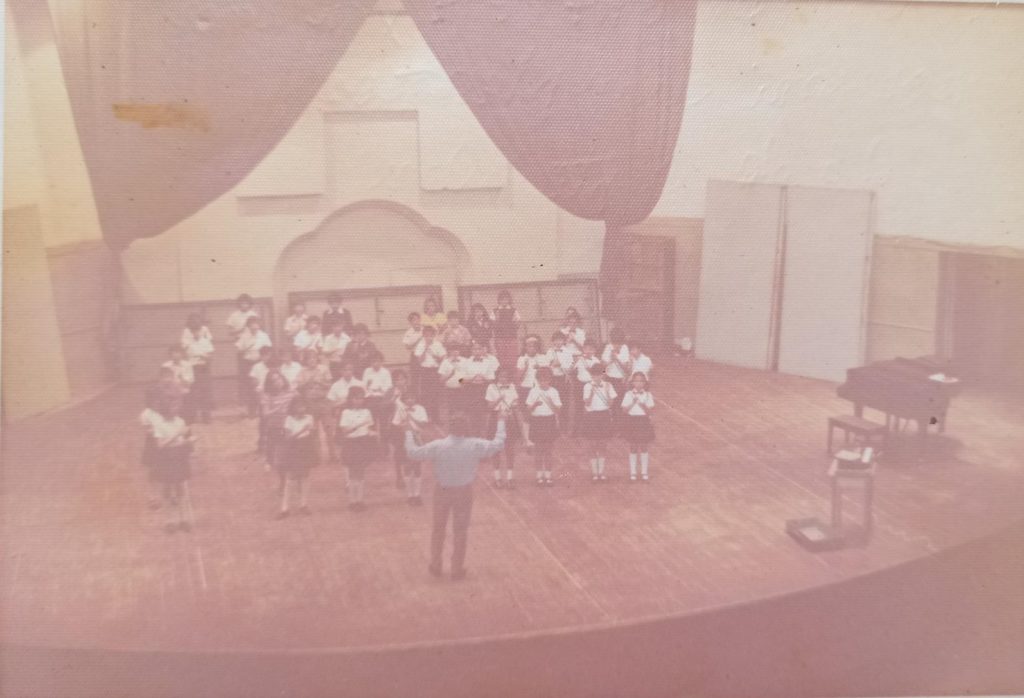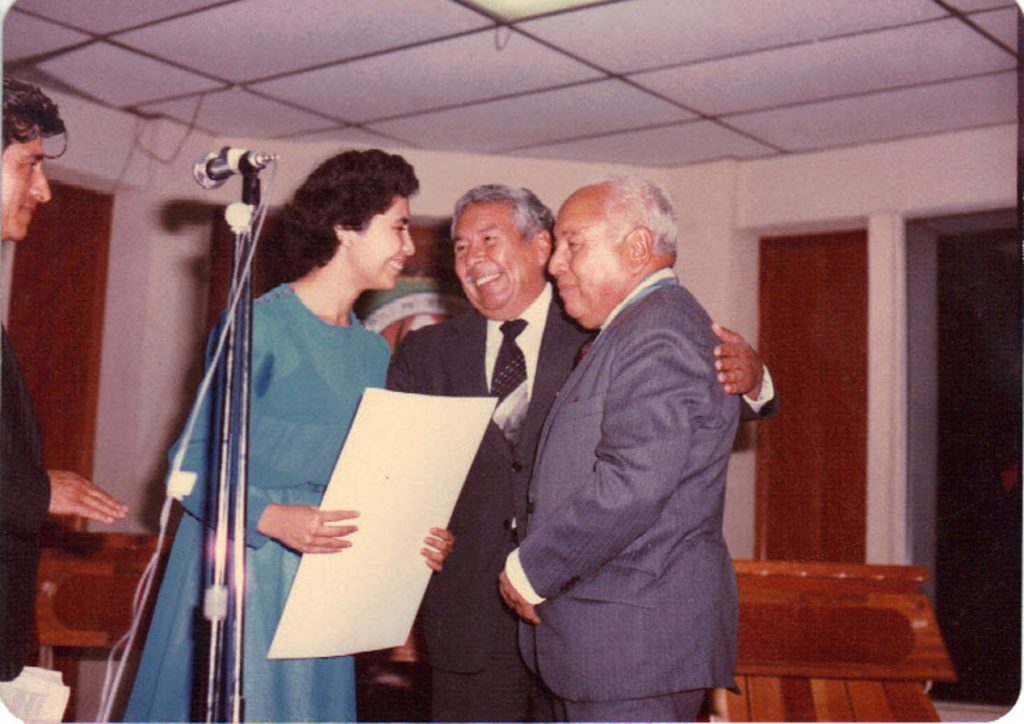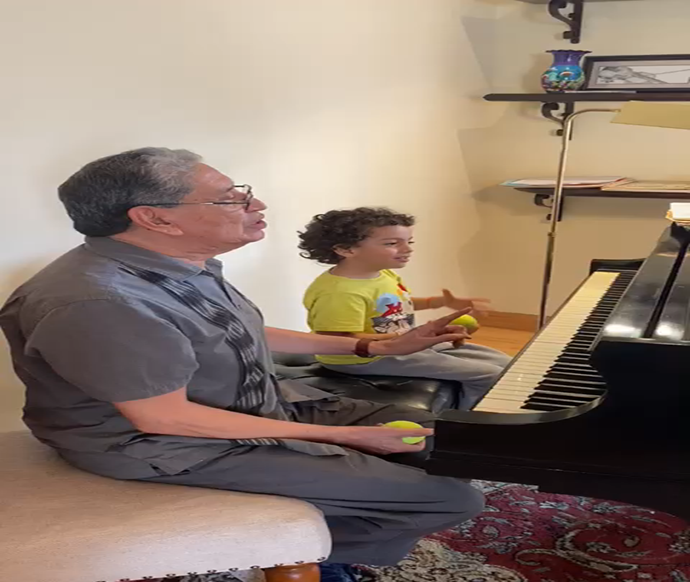
A Brief History of Dalcroze Eurhythmics in Guatemala
Making Dalcroze eurhythmics visible in Guatemala is a task that invites researchers to perform deep analysis. It was not possible to confirm the presence of a music teacher in Guatemala who held official accreditation endorsed by the Institut Jaques-Dalcroze in Geneva. However, the impact of this music pedagogy in the development of local musical education may in fact be traced to—and with more or less orthodox variants—its beginning in the twentieth century. Thus, this article presents an initial path of knowledge and the history of the distinguished educators who have contributed to the progress of music education in Guatemalan territory throughout the twentieth and twenty-first centuries.
Irene Brosse, Pioneer
Irene Brosse (1929–2020) was born in Belgium and arrived in Guatemala after the Revolution of 1944, likely with a group of artists who settled and grew professionally in this country. Even though a few teachers remember Irene Brosse, none of them could provide specific details regarding her arrival and stay in Guatemala. Nevertheless, the time period when she developed professionally, called the “Democratic spring,” was a period of intense social, cultural, artistic, and pedagogical growth that was promoted through the presidency of the republic, represented by the philosopher and educator Juan José Arévalo. As a result, the public institutions governing the higher education of artists encouraged the exchange of international faculty.
The National Ballet of Guatemala and the National School of Dance were consolidated at that time with the presence of the Belgian dancers Madame Marcelle Bonge de Devaux and Jean Devaux. Also arriving from Belgium was the pianist Augusto Ardonois, who worked with Irene Brosse at the National Conservatory of Music.
Julia Vela, founding faculty of the Modern and Folk Ballet Company of Guatemala and former director of the extinct General Direction of Fine Arts, recalled that she was a student of Irene Brosse at the private school of Marcelle Bonge when she was a child (likely between 1948–50) and from whom she acquired valuable knowledge. Later on during her adulthood and as a part of her training as choreographer, she had contact with Dalcroze pedagogy in Belgium (Batres, personal communication, February 12, 2022).
Besides her work in the private sphere, Irene Brosse worked in public institutions. Aydée Vásquez, a retired dance teacher, informs me that she received Dalcroze eurhythmics classes from Irene Brosse at the National School of Dance from 1948 to 1956. Even though she was not a student in the following years, the course continued until approximately 1960 and was specifically named “Dalcroze eurhythmics” and always taught by Madame Brosse, as she was named by her students and colleagues during the years the school was directed by the Belgian artist Joop Van Allen. Aydée Vásquez emphasized the importance of the relation between music and movement for better understanding of dance concepts in dancers and recalls the differences in feeling pulses, accents, and variations of gestures which allowed her to differentiate various meters and dance styles. She also remembers Mme Brosse playing the piano while the group reacted to the differences between waltzes, mazurkas, polkas, and other forms (Batres, personal communication, February 10, 2022).
Around the 1960s, Dalcroze eurhythmics was no longer taught by Mme Brosse but rather by the Guatemalan choreographer and teacher Antonio Crespo, possibly a student of Irene Brosse according to Mirna Sosa, who was a student of Crespo at that time (Batres, personal communication, February 15, 2022).
Mme Brosse taught a Dalcroze eurhythmics class at the National Conservatory of Music between 1960 and 1970. However, the course did not appear in the official course program. Relatedly, Lucía Armas refers that during her early years of dance training, she was taken to the National Dance School. Since she was very young, her mother was advised to register her at the National Conservatory to start with the Dalcroze eurhythmics class taught by Mme Brosse.
Even though Lucía Armas took eurhythmics at a young age (four to seven years old), the impact of this experience has lasted all her life. She clearly remembers the relationship between note values and movement, which was emphasized by Mme Brosse. She recalls precisely the dissociation between hands and feet, walking exercises, tempo changes, and the use of Greek modes. Lucía also relates music reading to movement, as well as the realization of melodic dictation while Mme Brosse improvised at the piano.
Lucía Armas comments that regardless of the small size of the groups, they had public presentations at the end of the school year in a hall which belonged to the Guatemalan American Institute (IGA). She reflects upon the lack of continuity of the Dalcroze eurhythmics course, which unfortunately did not favor the training of further generations of dancers and musicians on a larger scale (Batres, personal communication, February 15, 2022).
In relation to the Dalcroze eurhythmics course for the students of the National Conservatory, Benjamín Flores Chinchilla says: “When I was a student at the conservatory, Mme Irene Brosse was my Dalcroze eurhythmics teacher. At that time, I was a teenager, and I still did not have the desire to deepen my knowledge of music pedagogy. For this reason, since the course was not mandatory, I attended the class out of curiosity. Actually, there were not many students in the group. Mme Brosse made things work in such a way to have an appropriate classroom on the third floor which was large enough, with wooden floors, no desks, and a piano. Inside we moved freely, following her instructions. At that time, that way of teaching was not accepted by many people. Being musically trained in a traditional fashion, we, the students, did not understand why we had to “dance” (generic term which was often used in a pejorative way), if we were studying to be musicians, not dancers. As time went by, and under the administration of Manuel Gómez, I realized how important that course was.”
The South American Influence: Manuel Gómez Samayoa and Alfonso Alvarado
Manuel Gómez Samayoa and Alfonso Alvarado are probably the two Guatemalan music educators who have had the most influence in the dissemination of Jacques-Dalcroze principles at the local level. They were both music educators who received grants to study at the Instituto Interamericano de Educación Musical (INTEM) in Chile. This program was the result of an agreement between the University of Chile and the Organization of American States (OAS) to train music educators from Latin American countries with the commitment to return to their home countries. Both educators returned to Guatemala after being immersed in European active music education approaches, which were widely spread throughout the continent, particularly during the second half of the twentieth century. Their work encompassed both private and public educational spheres.
Manuel Gómez Samayoa
According to Benjamín Flores, Manuel Gómez held the position of first oboe in the National Symphony Orchestra for several years. At the same time, he was a professor at the National Conservatory of Music where he introduced the course “Ritmo Auditivo” (Auditive Rhythm) during the 1970s. This course was registered in the official study program of the institution; however, it was addressed to children only.
Manuel Gómez taught using several principles in his class: a) Dalcroze eurhythmics as a basis to develop musicianship, b) ear training exercises based on the Martenot method, c) Edgar Willems’s (1890–1978, Belgian music educator) philosophy for the development of other auditive skills and the attainment of musical awareness, d) the use of the recorder as a complementary resource for music reading.
He started his work in solitude, teaching in the same classroom Mme Brosse had used, who at the time had paused her work at the conservatory. Later on, Gómez’s work was acknowledged by the director of the conservatory. Choral director, trombonist, and music educator Antonio Elías Vidal Figueroa consolidated the program and named it “elementary music.” It consisted of five courses for children: 1) auditive rhythm, 2) musical language, 3) choir, 4) music appreciation, 5) instrument study.
Manuel Gómez invited one of his advanced students to become his assistant in this program: Benjamín Flores Chinchilla, who was mentioned earlier and who later was a professor at the Education School for Music Education Teachers “Jesús María Alvarado”. When visiting Guatemala, Shelyn Lynn, an American oboe student of Manuel Gómez, also worked as his assistant (Batres, personal communication, February, 16, 2022).

Alfonso Alvarado
Alfonso Alvarado, after the return of his first trip to Chile, incorporated auditive rhythm into the official degree plan of the music education degree at the Education School for Music Education Teachers “Jesús María Alvarado,” starting in 1967. At that time, all the music education teachers who graduated from the education schools (specialized schools for teachers which existed prior to the programs becoming university degree tracks) took auditive rhythm courses. For many years, Alfonso Alvarado was the most important faculty member of the National School for Music Educators and was succeeded later by Benjamín Flores.
Alfonso Alvarado combined Dalcroze principles with traditional Guatemalan music and had a deep influence on the next generation of music teachers since they had a dynamic, functional, and active vision that integrated body movement in the teaching-learning process of music (Batres, 2022).

The North American Influence: Elizabeth Macvean
In tandem with the South American influence of Dalcroze eurhythmics practice in Guatemala, we had the expertise and practice of Elizabeth Ainslee de MacVean, born in Guatemala to American parents. Her early music training was in Guatemala during elementary and junior high school. Later, she studied in the US and graduated with a degree in piano and music education from the University of Nashville, Tennessee.
As part of her music education training in the US, she took several courses related to Dalcroze and Orff practice. Upon her return to Guatemala, she worked at the American School. In addition, between 1975–1980, she organized summer camps for teachers who were trained in various active music education philosophies, which was new at that time.
The summer camps included courses in the following specialties:
- Music, dance, and movement: She incorporated Dalcroze principles together with her own ideas about dance and movement.
- Songs and games
- Instruments, music reading, and orchestra: This work was based on Orff philosophy
- Music appreciation
- Development of creativity

Seminar of the School for Teachers of Music Education “Jesús María Alvarado”
As part of the training at the Education School for Music Education Teachers during the years when the old degree plan was valid, the students (future music educators) received three main courses which incorporated Dalcroze principles:
- Auditive rhythm
- Music didactics. This course included the study of historical music education methods, among them Dalcroze eurhythmics.
- Seminar of music education problems in Guatemala. In 1980, this course had as a focus the theme, “A vision about music education methodologies” and was supervised by Ángel Ramírez Maldonado. That year, the project centered on Dalcroze pedagogy and was developed by Rubén Darío Flores Hernández, Edgar Miranda, and Patricia Sánchez (at that time students of the seminar).

Marta Sánchez’s Visit to Guatemala and the Work of Rubén Darío Flores and Edgar Cajas
Rubén Darío Flores had Marta Sánchez as a teacher—a pianist, Chilean educator, and specialist in Dalcroze eurhythmics who held a diplôme supérieur from the Institut Jaques-Dalcroze in Geneva—when he was a student at the Interamerican Institute of Music Education (INTEM) in Chile in 1995. That year, he took a workshop taught by Marta Sánchez together with dance students, music students from the conservatory, and music education students. In 1996, Ruben Darío Flores registered for a course of auditive rhythm at INTEM with Silvia Contreras Andrews, a Chilean professor, who, years later, earned her Dalcroze license at Carnegie Mellon University in Pittsburgh, Pennsylvania (Batres, personal communication, February 17, 2022).
Marta Sánchez was the founder of the Dalcroze training center in Pittsburgh in 1968. Carnegie Mellon University became the first higher education institution in the US to include Dalcroze eurhythmics as part of the core curriculum for university-level music. Moreover, its Dalcroze program could issue certificates and licenses and was the first program in the US to be validated by the Institut Jaques-Dalcroze of Geneva.
Starting in 1996, Rubén Darío Flores taught auditive rhythm at the Education School for Music Education Teachers “Jesús María Alvarado.” Additionally, since 1998, he has been promoting the importance of rhythm and movement perception to his students at the Christian Education School for Music Teachers “Alfredo Colom,” a private institution offering degrees in music education.
In 1996, Marta Sánchez visited Guatemala to teach a piano pedagogy workshop related to the Bastien piano method published by the Kjos Music Company; at the time, Marta worked for them. The visit was promoted by Dr. Edgar Cajas, who was the director of the “Alfredo Colom.”
In addition to the piano pedagogy workshop, Marta Sánchez offered a Dalcroze eurhythmics workshop for the students of the “Jesús Ma. Alvarado” school (mentioned earlier), the “Alfredo Colom” school, the National Music Conservatory, and members of the university chorus from the Universidad del Valle de Guatemala.

After Dr. Cajas earned his graduate degrees in music education and psychology at the University of Oklahoma in the US, he attended a Dalcroze summer workshop in 1998 at the Carnegie Mellon University training center during Marta Sánchez’s tenure as director. Prior to that, Dr. Cajas attended a Dalcroze workshop in Italy during an international conference of the International Society of Music Education (ISME). During his years as faculty and director of the aforementioned school “Alfredo Colom,” Dr. Edgar Cajas promoted the inclusion of Dalcroze principles in the training of future teachers. Currently, Dr. Cajas applies Dalcroze principles in his private piano studio (Batres, personal communication. February 18. 2022).
Dalcroze Eurhythmics Advocacy from the Latin American Forum of Music Education (Fladem), Guatemala Chapter
Since the founding of FLADEM Guatemala in 1999, guest faculty, both domestic and international, have offered courses and workshops either directly or indirectly related to Dalcroze pedagogy or to ideas of music and movement. Nevertheless, the only activity done by a licensed Dalcroze instructor was that by Elda Nelly Treviño in 2011 during the International Seminar in the city of Antigua. Other activities from 1998 to the present are related to music and movement topics; however, the faculty involved are not Dalcroze specialists.
Final Remarks
Following the growth of Dalcroze eurhythmics around the world and in particular in Latin America is a challenging and urgent endeavor. The role of the Education School for Music Education Teachers (Escuela Normal para maestros de Educación Musical) has been fundamental to the promotion of Dalcroze pedagogy and its applications. Through the work of Guatemalan music educators, auditive rhythm has become a cornerstone in the training of music teachers for over fifty years.
The greatest challenge in Guatemala is to anchor music education as an independent course within the general education system, which is difficult given the current political trends that attempt to blend it into general artistic education or to make it invisible.
The present article is the beginning of future research projects to recover the history of music education and Dalcroze eurhythmics pedagogy in Guatemala and Latin America.
The following list names a few of the activities done in Guatemala from different teaching perspectives related to the use of movement in music teaching since 1998 to the present:
- 1998. Workshop: “Applications of Dalcroze principles in the classroom,” by Edgar Cajas and Rubén Darío Flores as part of the conference: “Music Education in the third millenium”
- 2006. Workshop on regional traditional dances by the dancer Rodolfo Estrada
- Music and movement workshops for music educators and students by Ethel Batres, throughout Guatemala since the foundation of the program “¡Viva la Música!”
- February, 2022. Virtual lecture “Dalcroze eurhythmics from a Latin American perspective” by Dr. Elda Nelly Treviño (México) addressed to the faculty of the nine music conservatories of Guatemala. Sponsored by the National Ministry of Culture and General Direction of Artistic Education.
References
- Carnegie Mellon University. School of Music. Marta Sanchez Dalcroze Training Center (February 20th, 2022). https://www.cmu.edu/cfa/music/dalcroze/index.html
- Batres, E. (1997-2022) Personal archive of historical documents of the Foro Latinoamericano de Educación Musica (FLADEM Guatemala), and others.
This article was originally published in the Spring 2022 issue of Dalcroze Connections, Vol. 6 No. 2.